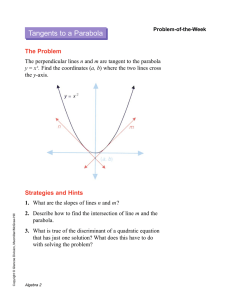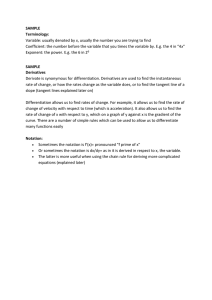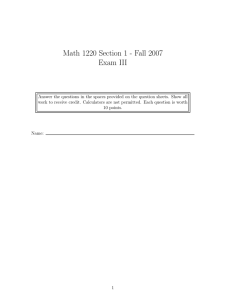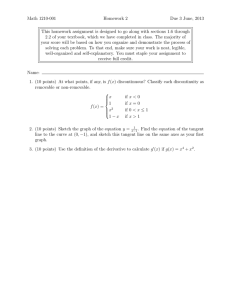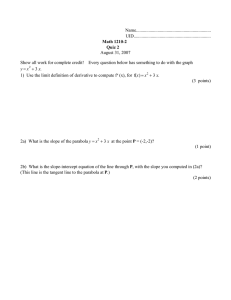Make Your Solutions Self-Explanatory
advertisement
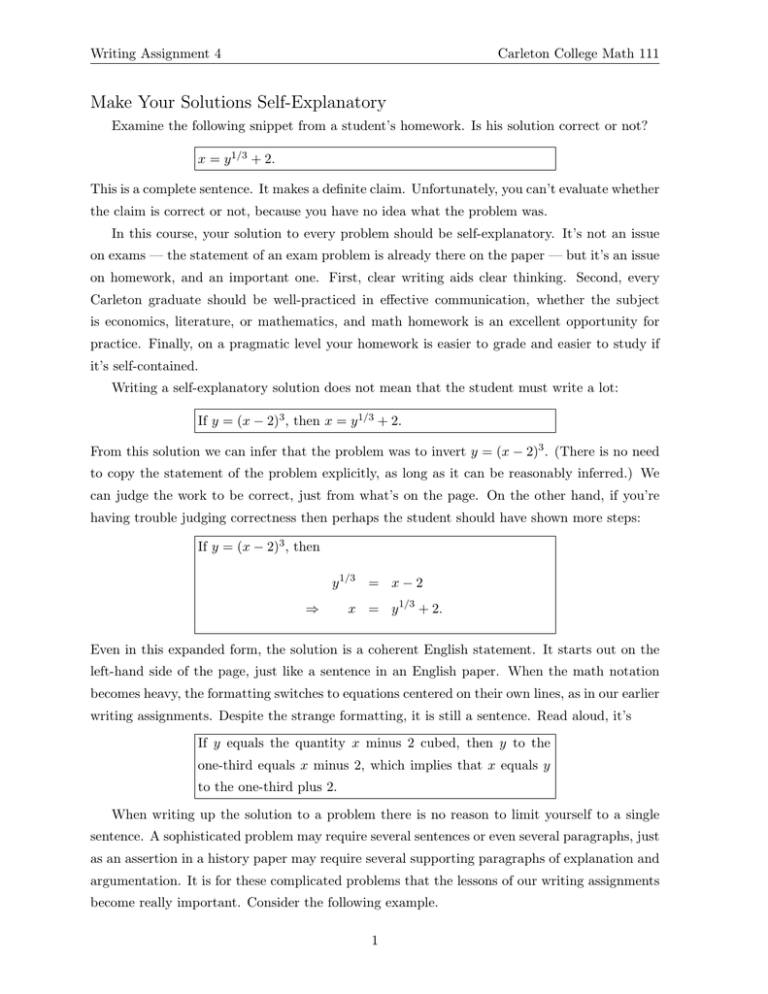
Writing Assignment 4 Carleton College Math 111 Make Your Solutions Self-Explanatory Examine the following snippet from a student’s homework. Is his solution correct or not? x = y 1/3 + 2. This is a complete sentence. It makes a definite claim. Unfortunately, you can’t evaluate whether the claim is correct or not, because you have no idea what the problem was. In this course, your solution to every problem should be self-explanatory. It’s not an issue on exams — the statement of an exam problem is already there on the paper — but it’s an issue on homework, and an important one. First, clear writing aids clear thinking. Second, every Carleton graduate should be well-practiced in effective communication, whether the subject is economics, literature, or mathematics, and math homework is an excellent opportunity for practice. Finally, on a pragmatic level your homework is easier to grade and easier to study if it’s self-contained. Writing a self-explanatory solution does not mean that the student must write a lot: If y = (x − 2)3 , then x = y 1/3 + 2. From this solution we can infer that the problem was to invert y = (x − 2)3 . (There is no need to copy the statement of the problem explicitly, as long as it can be reasonably inferred.) We can judge the work to be correct, just from what’s on the page. On the other hand, if you’re having trouble judging correctness then perhaps the student should have shown more steps: If y = (x − 2)3 , then y 1/3 = x − 2 ⇒ x = y 1/3 + 2. Even in this expanded form, the solution is a coherent English statement. It starts out on the left-hand side of the page, just like a sentence in an English paper. When the math notation becomes heavy, the formatting switches to equations centered on their own lines, as in our earlier writing assignments. Despite the strange formatting, it is still a sentence. Read aloud, it’s If y equals the quantity x minus 2 cubed, then y to the one-third equals x minus 2, which implies that x equals y to the one-third plus 2. When writing up the solution to a problem there is no reason to limit yourself to a single sentence. A sophisticated problem may require several sentences or even several paragraphs, just as an assertion in a history paper may require several supporting paragraphs of explanation and argumentation. It is for these complicated problems that the lessons of our writing assignments become really important. Consider the following example. 1 Writing Assignment 4 Carleton College Math 111 Suppose that e2x − 2ex − 3 = 0. Then (ex )2 − 2(ex ) − 3 = 0 ⇒ ex p (−2)2 − 4 · 1 · (−3) = 2·1 2±4 = 2 = 1 ± 2, 2± by the quadratic formula. Since ex > 0 for all x, it must be that ex = 3 and x = ln 3. This is a paragraph of three sentences. Mathematical notation is mixed in with plain text as needed, but it all sounds sensible when we read it aloud. In the second sentence the math notation becomes heavy, so we format it on its own lines, but after it settles down again we continue the sentence in plain text, starting from the left-hand side of the page. The reasoning is clearly explained. It’s roughly the correct level of detail, for a calculus student. Compare: e2x − 2ex − 3 = 0 √ 2± 4−4·−3 2 √ 2± 16 2 2±4 2 6 2 −2 2 3 x = ln 3 4 This is the typical sort of solution that a grader sees, from a student who is good at math but who has never worked on her writing. The grader finds it difficult to understand and score the solution. Another student, who didn’t already know how to solve the problem, would find this solution mysterious. That’s what we’re trying to avoid. Actually, here’s what’s really going on: The solution you just read is the student’s scratch √ work. You can actually see her figuring out the math (such as 16 = 4) as she goes along. But students are not supposed to hand in scratch work; they are expected to hand in a polished product, like the first solution to the problem above. So, once you have done the scratch work to figure out a problem for yourself, either edit or recopy it into a finished product to submit. Thus far we’ve considered only “pure” math problems about abstract functions and equations, disconnected from all practical meaning. A math student also encounters applied (“story”) problems involving quantities such as time, length, mass, and money. A key step in solving any applied problem is determining the relevant quantities and giving them names such as t, x, m, and P , so that we can compute with them. Whenever you use a symbol to represent a quantity in an applied problem, you must explicitly 2 Writing Assignment 4 Carleton College Math 111 introduce that symbol to the reader and explain its meaning. This is most commonly done using the word “let”. Let b be the number of bacteria in a culture at time t (in hours). Let b0 be the number at t = 0. If the bacteria reproduce at a continuous growth rate of 3% per hour, then b(t) = b0 e0.03t . Introducing notation is not just for applied problems. The following example is from 3.1 #59. The variable a is not mentioned in the problem, but we introduce it because it is useful. Consider the parabola y = x2 and the point (0, −4). Suppose that (a, a2 ) is a point on the parabola where the tangent line passes through (0, −4). Because y 0 = 2x, the tangent line at (a, a2 ) has slope 2a; because this line passes through (0, −4), its formula must be y = 2ax − 4. But (a, a2 ) is on the line, so a2 = 2aa − 4 ⇒ ⇒ a2 = 4 a = ±2. Thus (−2, 4) and (2, 4) are the two points on the parabola whose tangent lines pass through (0, −4). Exercises There is only one exercise, but it is different for each student. Later today I’ll e-mail you a problem to solve. If you have difficulty solving your problem, then I’ll be happy to help. Once you have solved it, you’ll write up a polished solution. It will be graded by another student and by me. If necessary, you’ll submit one or more revisions based on the feedback you receive. 3
